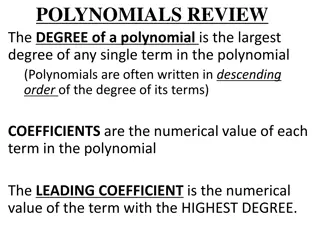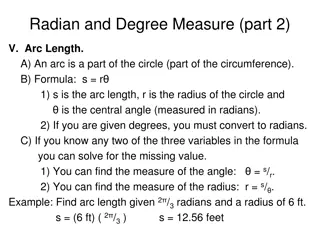Understanding Degrees of Comparison in English and Latin
Degrees of comparison in English involve three forms of adjectives - positive, comparative, and superlative. Adjectives are compared by adding suffixes or using adverbs. In Latin, comparisons are formed with regular, irregular, and incomplete adjectives. Comparative and superlative forms differ based on the adjectives' endings. Understanding these concepts helps in expressing comparisons accurately in both languages.
Download Presentation

Please find below an Image/Link to download the presentation.
The content on the website is provided AS IS for your information and personal use only. It may not be sold, licensed, or shared on other websites without obtaining consent from the author. Download presentation by click this link. If you encounter any issues during the download, it is possible that the publisher has removed the file from their server.
E N D
Presentation Transcript
Comparison of adjectives in English In the sentences, POSITIVE DEGREE COMPARATIVE DEGREE SUPERLATIVE DEGREE different bones are being compared with respect to their length. The three forms of the adjective long, longer, the longest express three different degrees of comparison -positive, comparative a superlative. In English adjectives are compared regularly either by adding er, the est to the positive or by placing the adverbs more, most before the positive. Some English adjectives are irregular in comparison cf. good-better- the best. This is a long bone This is a longer bone than that This is the longest bone of the human body,
Degrees of comparison in LATIN 1) Positive longus, a, um/ brevis, e 2) Comparative longior, ius/ brevior, ius 3) Superlative longissimus, a, um/ brevissimus, a, um
Typesofcomparison in LATIN 1) Regular: latus, a, um latior, ius latissimus, a, um 2) Irregular: magnus, a, um major, majus maximus, a, um 3) Incomplete: (supra) - superior, ius supremus, a, um
Regular comparison -COMPARATIVE Nominative of comparatives is formed by adding to the base of the positive the suffix -ior for masculine and feminine -ius for the neuter Positive Base Comparative M+F Comparative N Longus, a, um Long- Long-ior Long-ius Simplex, cis Simplic- Simplic-ior Simplic-ius Brevis, e Brev- Brev-ior Brev-ius Comparatives are declined like Nouns of III. Declension (DOLOR+CORPUS) ! Genitive sg. of comparative always ends in -ioris
Regular comparison -SUPERLATIVE Majority of superlatives are formed by adding to the base of the positive the suffix issimus, a, um| 6 adjectives add suffix limus, a, um. Adjectives ending in er form the superlative by adding suffix rimus, a, um to the masculine nominative singular of the positive. POSITIVE BASE SUPERLATIVE Longus, a, um Long- long-issimus, a, um Simplex, cis Simplic- Simplic-issimus, a, um Brevis, is Brev- Brev-issimus, a, um facilis, difficilis, similis, dissimilis, gracilis, humilis facil- difficil- simil- dissimil- gracil- humil- Facil-limus, a, um Difficil-limus, a, um Simil-limus, a, um Dissimil-limus, a, um Gracil-limus, a, um Humil-limus, a, um
Irregular comparison 2 adjectives are irregular in comparison Positive Comparative Superlative magnus, a, um large major, majus larger maximus, a, um the largest parvus, a, um small minor, minus smaller minimus, a, um the smallest
Incomplete comparison The following adjectives are partially irregular and some are defective In the positive and comparative degrees: Prepositio n Positive Comparative Superlative ante - anterior, ius - post - posterior, ius postremus, a, um supra - superior, ius supremus, a, um infra - inferior, ius infimus , a, um intra internus, a, um interior, ius intimus , a, um extra externus, a, um exterior, ius extremus, a, um























